Click on images to enlarge
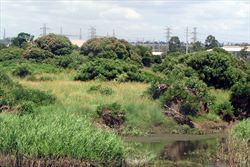
infestation (Photo: Sheldon Navie)
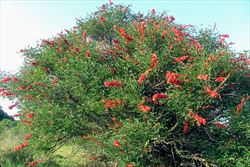
habit in flower (Photo: Sheldon Navie)

habit in fruit (Photo: Sheldon Navie)

habit in winter (Photo: Sheldon Navie)
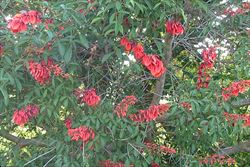
habit (Photo: Sheldon Navie)

younger stem with thorns (Photo: Sheldon Navie)
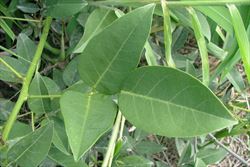
leaf with three leaflets (Photo: Sheldon Navie)
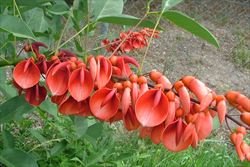
elongated flower cluster (Photo: Sheldon Navie)
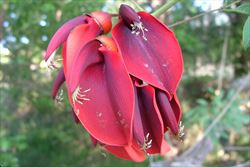
close-up of flowers (Photo: Sheldon Navie)
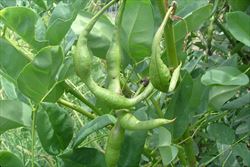
immature fruit (Photo: Sheldon Navie)
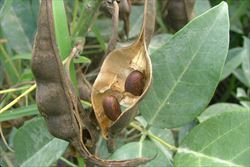
mature fruit with seeds (Photo: Sheldon Navie)
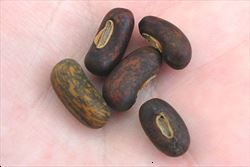
close-up of seeds (Photo: Sheldon Navie)
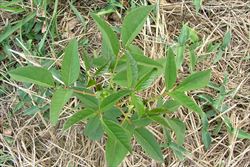
young plant (Photo: Sheldon Navie)
Scientific Name
Erythrina crista-galli L.
Family
Fabaceae (Queensland, the ACT, Victoria, Tasmania, and the Northern Territory)Fabaceae: sub-family Faboideae (New South Wales)Leguminosae (South Australia)Papilionaceae (Western Australia)
Common Names
Brazilian coral tree, cock's comb coral tree, cockscomb coral tree, cockspur, cockspur coral tree, common coral tree, coral tree, cry baby, cry-baby tree, crybaby tree, crybabytree, fireman's cap, fireman's cap tree
Origin
Native to South America (i.e. eastern Brazil, Bolivia, Peru, Paraguay, Uruguay and northern Argentina).
Cultivation
Cockspur coral tree (Erythrina crista-galli) is widely cultivated as an ornamental in the warmer parts of Australia. It is commonly grown in parks and gardens for its spectacular red flowers, which attract birds.
Naturalised Distribution
Naturalised in the coastal districts of eastern Australia. It is most common in south-eastern Queensland and north-eastern New South Wales, but is also occasionally naturalised in northern Queensland. Possibly also naturalised in the coastal districts of central New South Wales (i.e. near Sydney).
Also widely naturalised overseas, including in south-eastern USA (i.e. Florida, Louisiana, Mississippi and Georgia).
Habitat
This species is is most often naturalised along waterways, in swamps and wetlands, and in urban bushland. It is a potential weed of wetter temperate, sub-tropical and tropical environments in Australia.
Habit
An upright (i.e. erect) tree with a broadly spreading habit that loses its leaves during winter when growing in cooler regions (i.e. it is deciduous). It usually grows 5-8 m tall, but may occasionally reach up to 10 m or more in height.
Distinguishing Features
- a broadly spreading tree growing up to 6 m or more tall.
- its stems are sparsely covered in sharp thorns.
- its leaves are divided into three elongated leaflets.
- its scarlet red to dark red pea-shaped flowers are borne in large elongated clusters at the tips of the branches.
- its elongated, dark brown, pods are slightly constricted between each of the shiny mottled seeds.
Stems and Leaves
The older stems are brown or greyish in colour and have moderately rough bark. Younger stems are greenish in colour, shiny, and hairless (i.e. glabrous). The stems and leaf stalks (i.e. petioles) are sparsely covered with sharp thorns or prickles that are occasionally hooked (i.e. recurved).
The alternately arranged leaves are borne on stalks (i.e. petioles) 5-10 cm long and are made up of three leaflets (i.e. they are trifoliate). These leaflets (3-6 cm long and 2-5 cm wide) are egg-shaped in outline (i.e. ovate) or oval (i.e. elliptic) in shape. They are hairless (i.e. glabrous), with entire margins and pointed tips (i.e. acute apices). The two side (i.e. lateral) leaflets are borne on thin stalks (i.e. petiolules) that are 5-10 mm long, while the end (i.e. terminal) leaflet has a stalk (i.e. petiolule) that is significantly longer (i.e. 30-40 mm long).
Flowers and Fruit
The flowers are scarlet red to dark red in colour and pea-shaped in appearance (4-5 cm long). They are borne in large, loose, elongated clusters (8-30 cm long) at the tips of the branches (i.e. in terminal racemes), with each cluster usually having 20-40 flowers. The largest and uppermost petal of each flower (i.e. the standard) is bent upwards or backwards (i.e. recurved) when the flowers are fully open. Flowers also have two inconspicuous side petals (i.e. the laterals or wings), that are about 10 mm long, and a folded lower petal (i.e. keel) about 3-3.5 cm long (which is actually derived from two petals that are fused together along the fold). These flowers also have five sepals that are fused into a tube (i.e. calyx tube) about 10 mm long, and ten long stamens. The stalks (i.e. filaments) of nine of these stamens are fused together into a tube, while the other stames is entirely separate (i.e. the stamens are diadelphous). The ovary is very elongated in shape and is topped with a style and a small stigma. Flowering occurs mostly during spring and early summer.
The fruit are large elongated pods (8-22 cm long) that turn from green to dark brown or blackish in colour as they mature. These pods are sometimes somewhat curved (i.e. falcate) and gradually taper to a pointed tip (i.e. acute apex). They contain several seeds, with slight constrictions between each of the seeds, but are otherwise cylindrical in shape. The large and hard seeds (about 10-15 mm long) are slightly kidney-shaped (i.e. reniform), dark brown or blackish in colour, and often with a somewhat mottled appearance.
Reproduction and Dispersal
This species reproduces by seed and also vegetatively via branches and pieces of stems that take root when they become lodged in moist environments.
Its pods, seeds and stem segments are carried by floodwaters into creeks and wetlands where germination occurs. They can also be spread into natural environments in dumped garden waste. Populations are then dispersed throughout catchments by water movement and subsequent floods.
Environmental Impact
Cockspur coral tree (Erythrina crista-galli) is an emerging environmental weed in New South Wales and Queensland. Though it currently has a scattered distribution, it is quickly becoming more widespread and common in the coastal districts of eastern Australia. It has escaped cultivation and is invading natural areas, particularly along waterways and in wetlands.
Cockspur coral tree (Erythrina crista-galli) is currently listed as a priority environmental weed in two Natural Resource Management regions. It is of most concern in the coastal districts of south-eastern Queensland and central and northern New South Wales. In south-eastern Queensland it is ranked among the top 200 most invasive plants, and is most commonly found in highly disturbed low-lying swampy areas that do not have much tree cover. In New South Wales it is most troublesome in the Wilsons and Richmond River catchments on the north coast. However, it also apears on environmental weed lists for the wider Sydney and Blue Mountains region and is described as a significant woody weed within the Mullet Creek Catchment in Sydney (i.e. in the Warriewood Wetlands and in Irrawong Reserve).
In its native Argentina, cockspur coral tree (Erythrina crista-galli) is reported to form pure stands on the periodically flooded shores and islands in the Plate River estuary. Therefore, it may have the potential to form such stands in low-lying wetland areas and floodplains in the tropical, sub-tropical and warmer temperate coastal regions of Australia.
Legislation
This species is declared under legislation in the following states and territories:
- New South Wales: Class 4 - a locally controlled weed. The growth and spread of this species must be controlled according to the measures specified in a management plan published by the local control authority and the plant may not be sold, propagated or knowingly distributed (in the Manly local authority area only).
- Western Australia: Prohibited - on the prohibited species list and not permitted entry into the state.
Similar Species
Several other species of coral trees (Erythrina spp.), some of which are native, can be confused with cockspur coral tree (Erythrina crista-galli). The most common of these are the weedy common coral tree (Erythrina x sykesii) and the native bat's wing coral tree (Erythrina vespertilio). These species can be distinguished by the following differences:
- cockspur coral tree (Erythrina crista-galli) has leaves with relatively slender oval (i.e. elliptic) or egg-shaped (i.e. ovate) leaflets that are entire and usually less than 7 cm long and wide. Its scarlet red or dark red flowers (40-50 mm long) are loosely clustered in elongated inflorescences and appear with the leaves in spring.
- common coral tree (Erythrina x sykesii) has leaves with broad leaflets that are entire and often more than 7 cm long and wide. Its scarlet red or reddish-orange flowers (30-50 mm long) are densely and tightly clustered in short inflorescences and usually appear before the leaves in spring.
- bat's wing coral tree (Erythrina vespertilio) has very broad leaflets that are usually two or three-lobed and up to 12 cm wide. Its scarlet red or dark red flowers (up to 30 mm long) are loosely clustered in elongated inflorescences (10-30 cm long) and appear with the leaves in spring.

